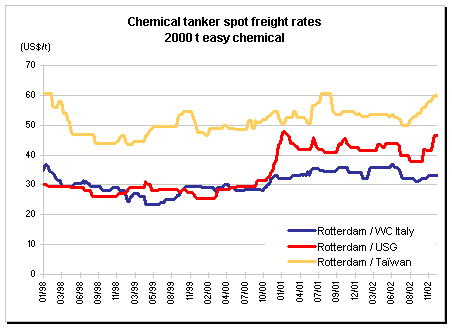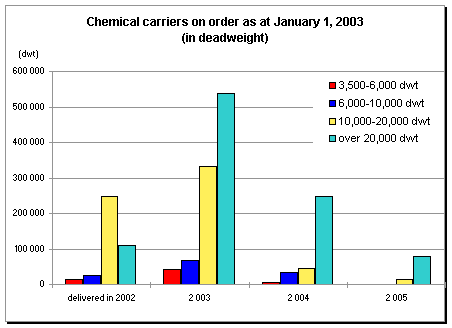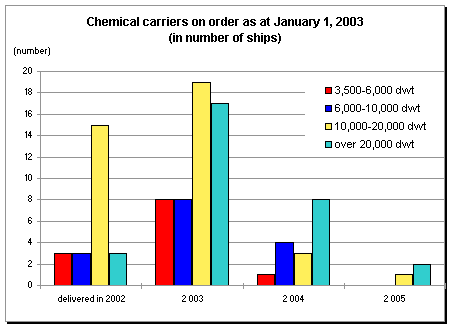
|
|
The Chemical Carrier Market in 2002
|
The freight market
The fleet
|
|
This time last year we gave a fairly positive
assessment as to the development of the chemical carrier market.
Our analysis highlighted the return of a better balance in the supply and demand of tonnage, a
general improvement in the financial results of the main owners and European operators, as well as
the limited drop in freight rates in the fourth quarter in contradiction to all other shipping
sectors. We ended by questioning the extent of the world economic slowdown, which started in the
spring of 2001 with the recession in the American economy, hoping for a recovery before the end of
2002.
One year later, we can observe that the stated facts remain largely unchanged with the exception of
the world economic recovery, which has not taken place this year and which has been pushed back to
at best the second half of 2003.
The balance between the tonnage supply and demand still applies as delivery of new carriers has been
restricted in the course of the past year. At the same time, the orderbook for chemical carriers
remains at a low level, despite a significant pick-up in orders in 2002, compared to 2001, which was
particularly poor in this respect.
|
| Freight rates |
|
|
During 2001 freight rates increased overall by some
10 to 20 %, with the European and Transatlantic trade being at the lower end, and markets into Asia
being at the upper end. In 2002 the market gave no sign of a trend one way or the other, and the
players in the petrochemical sector went through the year with the uncertainties surrounding the
eventual recovery in the world economy.
The North European market remained at healthy levels with freight rates improving by about 10 % at
the beginning of the year. Then following a good volume of contractual nominations, freights
fluctuated around previous levels up until the third quarter, to finally rise significantly at the
end of the year thanks to a very sustained spot market.
The Mediterranean trade is still divided in two, based on the age of vessels and the approvals
required by the main charterers. Consequently there is a two-tiered market, which basically stayed
steady over the whole year.
On the other zones of trade, from the Mediterranean to North Europe and back, rates had mixed
fortunes. For North Europe the supply of carriers is becoming progressively reduced, following a
fear by certain owners of tighter controls and multiple inspections by authorities in the main
ports. Consequently on this traffic, charterers faced a shortage of supply and variations in freight
rates from 10 to 20 % within two to three months, with peaks in the spring and the end of the year,
whereas the rest of 2002 was relatively stable.
Spot Mediterranean bound movements remained at slightly lower levels with the main volume of
business being covered under term contracts.
Renewal of contracts for 2003 were mostly made at unchanged levels to 2002 or else very similar,
with some obtaining a modest increase of about 5 %.
It is necessary to adjust these rates on European movements as owners pay today for their bunkers at
much higher prices and some are suffering from the dollar devaluation against the euro as numerous
freight contracts are based in dollars.
On the U.S. / Europe traffic, the market suddenly
took off at the beginning of March, to peak in April. Significant movements of styrene and cumene
were fixed by producers and traders following some technical shutdowns in Europe. As a result rates
for lots of 2,000 tons went from $ 35 to $ 45 per ton. Thereafter freights experienced a steady drop
with rates finding levels as at the end of 2001.
On westbound Atlantic trade, the market firmed up as from the beginning of the second quarter, then
experienced a peak during the summer with a falling off down to $ 40 per ton for
2,000 ton lots, to finally finish the year with a 15 % increase. The main spot movements out of
Europe were with cargoes of methanol, MTBE and sulphuric acid.
Movements from Europe to Asia were largely term contracts, with steady volumes in the hands of the
four main chemical owners. Spot freight rates for 1,000 tons of chemical products remained at about
$60 per from the Rotterdam area to main Asian ports, with the same for 2,000 ton lots, which
increased in the summer and improved progressively to $ 50 to $ 60 per ton.
On a general view point, due to the large number of term nominations and a well-sustained spot
market for special grades, the level of ships' employment was good and freight rates were stable
throughout the year.
|
|

|
| The fleet |
|
|
Chemical carrier owners are probably today in a
better situation than a few years ago. The number of ships available is more or less in line with
demand and only a deterioration of the world economy is likely to disturb this balance.
In an attempt to modernise and increase their fleet at minimum risk, some owners have started in the
course of the year 2002 to place orders backed by time charters for a minimum of 5 to 7 years with
purchase options of the new tonnage to be built in Japan. Stolt, Jo Tankers, TMM, Tokyo Marine and
Iino Kaiun have signed a number of contracts with deliveries in 2003 to 2005.
This is a new approach by Western owners, which have been in the habit of placing orders with
European shipyards. These vessels are less sophisticated with fewer tanks and segregations, but
built to more attractive financial conditions. More owners and operators could be interested in the
future.
Since the beginning of the year 24 ships totalling 0.4 million dwt have entered into service. The
number of purely chemical carriers (with stainless steel tanks) on order at the end of 2002 was 71
of which 21 were below 10,000 dwt and 50 above this size, for respectively 0.15 million and 1.25
million dwt. This figure is considerably higher than the total at the end of 2001, which was 44
ships totalling 0.97 dwt, but is below the number of ships on order before the Asian crisis of 1998
with 107 ships and a total of 1.69 million dwt of which 42 were under 10,000 dwt and 65 above as at
end 1997.
Scrapping of chemical carriers was stable in 2002 with a new parameter however, namely an additional
number of large sizes being withdrawn. Last year there was a total of 8 ships for slightly more than
59,000 dwt, whereas this year there were 9 ships for a total of 150,000 dwt (of which 4 ships over
20,000 dwt).
This trend towards scrapping chemical carriers has been considerably reinforced by charterers
insisting on double-hulls, but also to the arrival of the various generations of big chemical
carriers built in the mid 70's and whose characteristics no longer correspond to today's needs
and criteria.
|
|


|
|
Even more than in previous years, the absence of any
firm trend in the development of the market has meant that owners have decided to reduce their costs
to a maximum in order to preserve their margins. Owners are seeking to optimise costs, by reducing
crews and through partnerships on certain routes. For example Stolt and Jo Tankers have reached an
agreement for a better co-ordination of operations on port calls for their vessels leaving the Gulf
of Mexico to Asia, whilst preserving their commercial independence.
With the same objective of fleet optimisation, the market is awaiting the decision of the European
Commission on the creation of a commercial pool between Vopak-Essberger and Stolt Nielsen Inter
Europe Services requested by the two owners now for more than a year.
In this uncertain climate owners are seeking to consolidate their positions, whilst trying to obtain
improvements in productivity. The decreasing number of small carriers on order and the concentration
of big chemical carriers in the hands of fewer and fewer operators, are some of the direct
consequences of the sluggish market we have had for the last three years.
If this new situation looks like lasting longer, attempts at mergers and buy-outs and the creation
of pools, could in the future be multiplied, thus limiting the diversity and competitiveness of the
chemical carrier market.
|
Shipping and Shipbuilding Markets in 2002
I N D E X
|